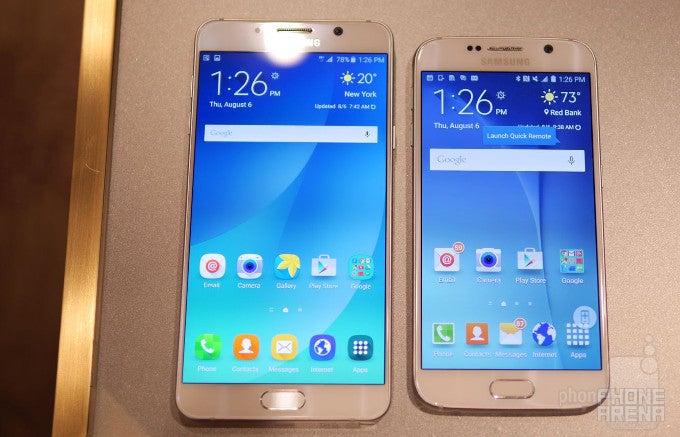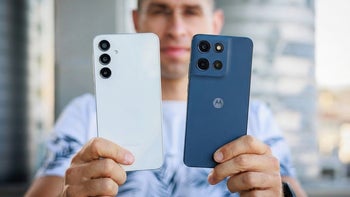Samsung Galaxy Note5 vs Galaxy S6: first look

The end of an era for Samsung as it skips microSD card slot and removable battery
There is indeed a striking similarity in terms of the look and feel of the two Samsung phones (much like Apple’s iPhone 6 and 6 Plus that share the same design approach), and the two phones also come with very similar hardware: a 14nm Exynos 7420 octa-core system chip, latest-gen AMOLED display with great power efficiency and color reproduction, as well as a 16-megapixel main cameras with optical stabilization.How do they differ and how are the similar? Let’s find out.
Design
The main camera also protrudes slightly out the back on both phones, and the two come with a heart-rate sensor, and a LED flash.
This being a Note series device, it comes with a new and improved stylus (something that is not present in the Galaxy S6). In terms of pure mechanics, you can now gently press the slightly protruding tip of the stylus and it automatically pops up thanks to a new, built-in spring mechanism. A neat little touch!
Display
Samsung has been improving its AMOLED displays at an amazing pace, and while just a year and a half ago there were severe issues with color quality, these days AMOLED screen on top Samsung phones look much, much better.
The Galaxy Note5 is no exception with its 5.7-inch Super AMOLED display with Quad HD resolution (1440 x 2560 pixels). The Galaxy S6, in comparison, also comes with a Quad HD resolution, but - thanks to the smaller size of the display - it ends up being sharper with pixel density of the amazing 577ppi in comparison with its 518ppi. In reality, this difference is quite hard to notice as both appear perfectly sharp at regular viewing distances. The one area, where resolution still matters is virtual reality, as with amplifying VR lenses, every pixel gets blown up, and this difference might be noticed.
On the Note5, you have the same color calibration profiles as on the S6: ‘Adaptive’ being the default mode, but for most accurate color reproduction the ‘Basic’ mode remains the most appropriate choice.
Interface and Stylus functionality
The Galaxy Note5 runs on the latest Android 5.1.1 Lollipop with the newest version of TouchWiz on top of it, and this time around, the change in TouchWiz is quite evident. The Note5 features a different set of icons - many of them redrawn and now coming with rounded corners, but still retaining their slight cartoonish vibe.
We have an S Pen stylus on the bottom, which allows you to interact with your Note5 in a way that the iPhone 6 Plus doesn't from the get-go. The Air Command menu, which is the feature hub that unlocks the true potential of the S Pen, is revamped as well. On top of it all, the stock iconography has also seen some changes - Samsung has decided to adorn the UI with icons that have slightly more curved edges.
Then, you have the unique functionality that comes with the S Pen, and - naturally - Samsung has added some improvements here as well. The most important one is the option to pull out the S Pen and draw right on the lock screen (yes, you draw in white on a black background) - quick and very useful.
Processor and Memory
Samsung surprised the industry by being the first in smartphone chip race to arrive at 14nm manufacturing with its Samsung Galaxy S6 that was launched with the Exynos 7420 system chip. The Galaxy Note5 launches with the same Exynos octa-core 7420, an octa-core chip with four high-performance Cortex A57s running at up to 2.1GHz and four power-efficient A53s running at up to 1.5GHz
The base model of the Note5 comes with 32GB of internal storage - just like the Galaxy S5 - and it’s fast-speed eMMC type of storage. The big disappointment for many Samsung loyalists is that the Note5 (again, like the Galaxy S6) does not have a microSD card slot and you can’t expand the existing memory. At the same time, we’re seeing a massive move to streaming music and cloud services for photos and videos, which should alleviate a lot of the burden put on the internal storage in earlier years.
Camera
The new Samsung Galaxy Note5 features a 16-megapixel main (rear-facing) camera with support for optical image stabilization (OIS) and an LED flash, while up front, the phone features a 5-megapixel selfie shooter. While there may be changes and improvements in software, it is likely that this is the same or similar setup as the one used in the Galaxy S6, which uses the 16-megapixel Sony IMX240 1/2.6” sensor with 1.2 micron pixels and 16:9 native aspect ratio.
Large, 16-megapixel main camera with improved Pro mode
The technological specs, however, don’t tell all that much about image quality, which is hugely dependent on speed of capture, auto-focusing capabilities, and naturally the way the image is rendered.We are yet to draw more detailed conclusions about the Galaxy Note5’s camera performance, but the initial impressions are for a snappy camera that captures great images. We also noticed that the double-click quick activation shortcut is present here as well, and Samsung has added the option to control shutter speed in the Pro camera mode. Videos can be captured at up to 4K at 30 frames per second.
Battery life
The battery on the Galaxy Note5 is a 3000mAh one, a reasonable size that allows the phablet to be thinner than last year's Note 4. It’s hard to make any definitive conclusions about battery life at such an early stage, but given Samsung’s rapid pace of display innovation, we can make some assumptions.
The new generation of AMOLED screens consume minimal amounts of power - and with the switch to the more power-efficient 14nm system chip, we expect the Galaxy Note5 battery life to be on par or higher than last year’s Note 4. As to the Galaxy S6, we do expect the Note5 to outperform it by a slight margin.
Conclusion
The Samsung Galaxy Note5 brings the modern and stylish design of the Galaxy S6 in a larger, phablet-sized body, and it ups the performance a notch, while adding the neat functionality of the S Pen. It’s an absolute monster in terms of specs as well: with the latest Exynos 7420 chip, 4GB of RAM, this phone is future proof.
As to our direct comparison with the Galaxy S6, it is the size that will be the determining factor here: the much easier manageable S6 is also pocket-friendly, while the Note5 features the larger display which is great for heavy media (ab)users.
If you’re wondering whether the bump in specs alone is worth upgrading, the answer is most likely a ‘no’: after all, the Galaxy S6 features a similar silicon heart.
As to our direct comparison with the Galaxy S6, it is the size that will be the determining factor here: the much easier manageable S6 is also pocket-friendly, while the Note5 features the larger display which is great for heavy media (ab)users.
If you’re wondering whether the bump in specs alone is worth upgrading, the answer is most likely a ‘no’: after all, the Galaxy S6 features a similar silicon heart.
Follow us on Google News














Things that are NOT allowed:
To help keep our community safe and free from spam, we apply temporary limits to newly created accounts: